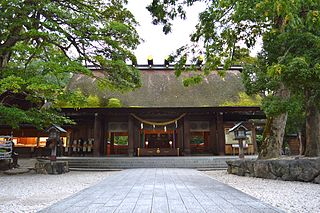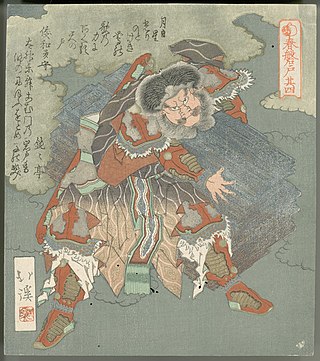Ame-no-Koyane-no-mikoto is a kami and a male deity in Japanese mythology and Shinto. He is the ancestral god of the Nakatomi clan, and Fujiwara no Kamatari, the founder of the powerful Fujiwara clan. An Amatsukami, 'Kami of heaven', he resides in Takamagahara.

Hata clan was an immigrant clan active in Japan since the Kofun period (250–538), according to the history of Japan laid out in Nihon Shoki (720).
Kuni no miyatsuko (国造), also read as kokuzō or kunitsuko, were officials in ancient Japan during the Yamato period who governed provinces called kuni.

The Suwa clan, also known as the Jin or Miwa clan was a Japanese shake and samurai family. Originating from the area encompassing Lake Suwa in Shinano Province, it was originally a family of priests who served at the Upper Shrine of Suwa located on the southwestern side of the lake. By the Kamakura period, it thrived as a prominent samurai clan with close ties to the shogunate.
Shinsen Shōjiroku is an imperially commissioned Japanese genealogical record. Thirty volumes in length, it was compiled under the order of Emperor Saga by his brother, the Imperial Prince Manta. Also by Fujiwara no Otsugu and Fujiwara no Sonohito et al. It was initially completed in 814, but underwent a revision to be recompleted in 815.

Kono Jinja (籠神社) is a Shinto shrine in the Ōgaki neighborhood of the city of Miyazu in Kyoto Prefecture, Japan. It is the ichinomiya of former Tango Province. The main festival of the shrine is held annually on April 24.The shrine is also called the Moto-Ise Kono Jinja (元伊勢籠神社), and its kannushi has been in the Amabe clan since the Kofun period.
Tamayori-hime is a goddess in Japanese mythology. Her name is spelled as 玉依毘売命 in the Kojiki and 玉依姫 in the Nihon Shoki.

Ame-no-tajikarao (アメノタヂカラオ) is a Japanese deity (kami) who appears in Japanese mythology. Ame-no-tajikarao is written as 天手力男神 in Kojiki, and 天手力雄神 in Nihon Shoki. Tajikarao's name means heaven hand power.

Takeminakata (タケミナカタ), also known as Minakatatomi or Takeminakatatomi, is a kami in Japanese mythology. Also known as Suwa Myōjin (諏訪明神) or Suwa Daimyōjin (諏訪大明神) after Suwa Grand Shrine in Nagano Prefecture in which he is enshrined alongside his consort Yasakatome, Takeminakata is historically worshiped as a god of wind, water and agriculture, as well as a patron of hunting and warfare, in which capacity he enjoyed a particularly fervent cult from various samurai clans during the medieval period such as the Hōjō or the Takeda. Takeminakata was also held to be the mythical ancestor of certain families who once served at the shrine as priests, foremost among them being the Suwa clan, the high priests of the Upper Shrine of Suwa who were also revered as living vessels of the god.

Moreya or Moriya is a Japanese god who appears in various myths and legends of the Suwa region in Nagano Prefecture. The most famous of such stories is that of his battle against Takeminakata, the god of the Grand Shrine of Suwa.
Amenohoakari (天火明) is a god of sun and agriculture in Japanese mythology. His descendants are called Tenson-zoku.

The Shake (社家) was a Japanese social class and the name for families that dominated Shinto shrines through hereditary government offices and priestly positions. Officially abolished in 1871, with 14 shake families granted hereditary nobility (Kazoku), most shrines were however unaffected, and at many shrines hereditary succession of former shake families continues to this day. Prominent shake families include the Nakatomi family and the Suwa family.
Hikoyai-no-Mikoto (日子八井命) was a member of a Japanese imperial clan from the Kojiki and other sources. He is one of the three princes born to Himetataraisuzu-hime on the banks of the Sakai River, and the eldest of the three. The name does not appear in the "Nihon Shoki" and there are no other names that are believed to be the same person. Hikoyai-no-Mikoto is the first son of Emperor Jimmu and Empress Himetataraisuzu-hime. His brothers are Kamuyaimimi and Emperor Suizei. After the death of Emperor Jimmu, Empress Himetataraisuzu-hime marries her stepson Tagishimimi, who would be considered a step-brother to Hikoyai-no-Mikoto and his brothers. Tagishimimi then attempts to assassinate the brothers, but instead is killed by Suizei who becomes the second emperor. Hikoyai-no-Mikoto does not have any significant role in the story and does not play an active role in the narrative. This is not uncommon in Japanese myths, where there are often brothers who do not play an active role in the story.

Tsukiyomi Shrine is a Shinto shrine located in Nishikyō Ward, Kyoto, Japan. It was named as a Myōjin Taisha in the ancient Japanese religious book Engishiki. Tsukiyomi Shrine is one of the "Matsuo Seven Shrines" (松尾七社), and a subsidiary shrine of Matsunoo Taisha 400 meters to the north. Its annual festival is on October 3.

Yamato no Kuni no Miyatsuko was a title held by the clan who ruled the central region of the later Yamato Province. Kuni no Miyatsuko were regional rulers subordinate to the Emperor of Japan. After the position was abolished they remained prominent as the priests of Ōyamato Shrine. Other kuni no miyatsuko this happened to include the Izumo clan of Izumo-taisha, the Aso clan of Aso Shrine, the Owari clan of Atsuta Shrine, the Munakata clan of Munakata Taisha, and the Amabe clan of Kono Shrine
Miyazu-hime the wife of Yamato Takeru was a member of the Owari clan. She is a kami of Atsuta Shrine.
The Owari clan is a Japanese clan. The clan were originally Kuni no miyatsuko but after the abolition of the role they took on a priestly role at Atsuta Shrine. They share this history with the Izumo clan of Izumo-taisha, the Aso clan of Aso Shrine, the Munakata clan of Munakata Taisha, the Amabe clan of Kono Shrine and the Yamato clan of Ōyamato Shrine.
Takakuraji is a Japanese mythological figure. He helped with Jimmu's Eastern Expedition. Takemikazuchi placed his sword Futsu-no-mitama (布都御魂) in Takakuraji's warehouse. Takakuraji found it and gave it to Jimmu, after being told to do such in a dream.

The Izumo clan is a Japanese noble family descended from Ame no Hohi who used to rule Izumo Province and run Izumo Taisha today.

The Aso clan (阿蘇) is a Japanese clan associated with Aso Shrine. They descend from Kamuyaimimi. The clan were originally Kuni no miyatsuko but after the abolition of the role they took on a priestly role at Aso Shrine, they share this history with the Izumo clan of Izumo-taisha, the Owari clan of Atsuta Shrine, the Munakata clan of Munakata Taisha, and the Yamato clan of Ōyamato Shrine.











